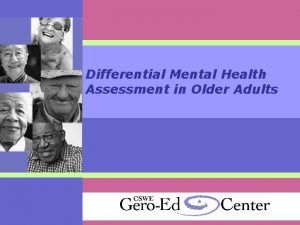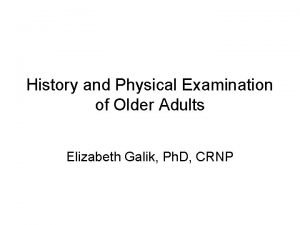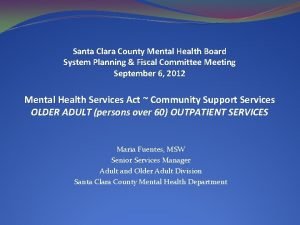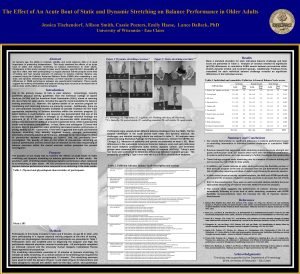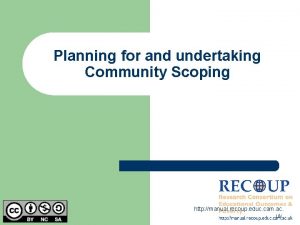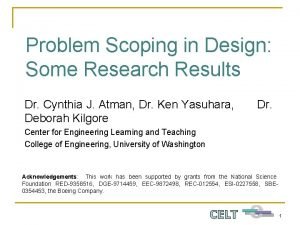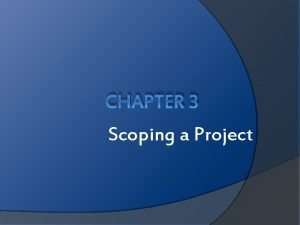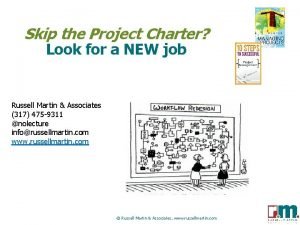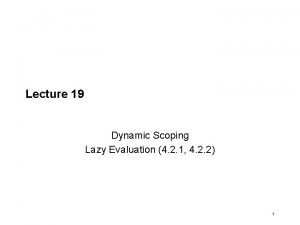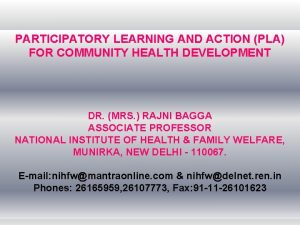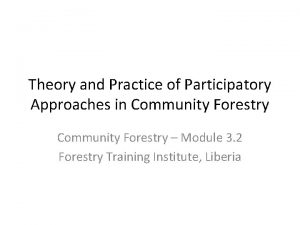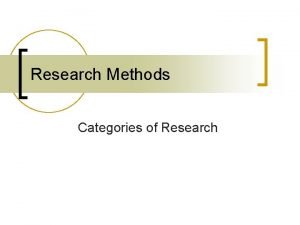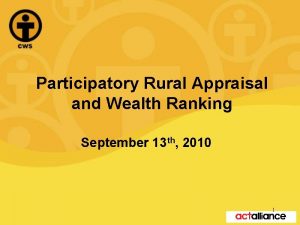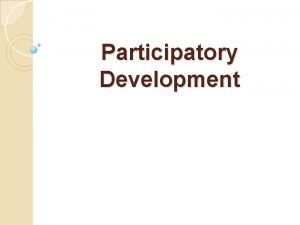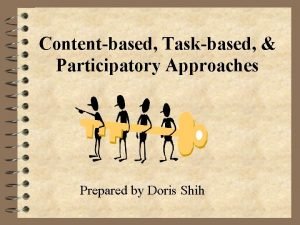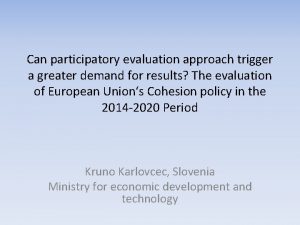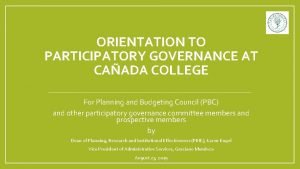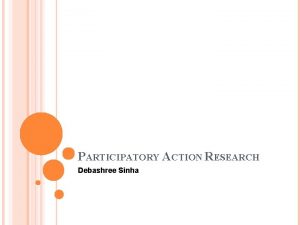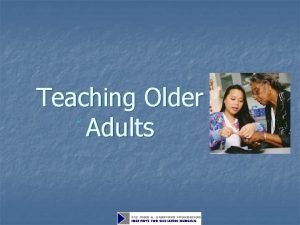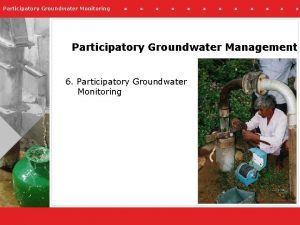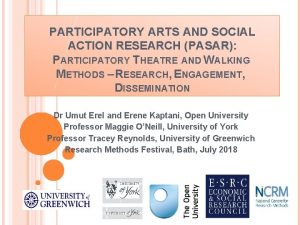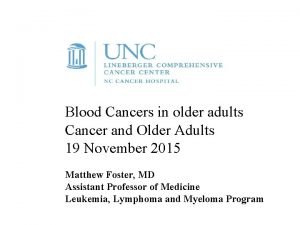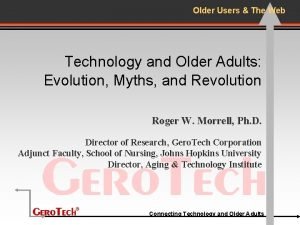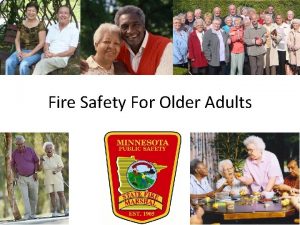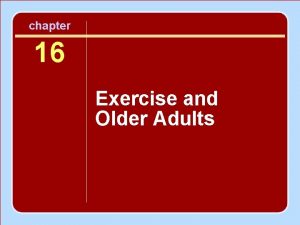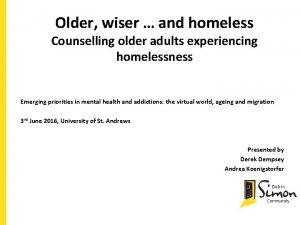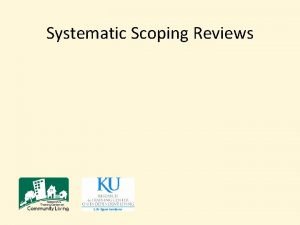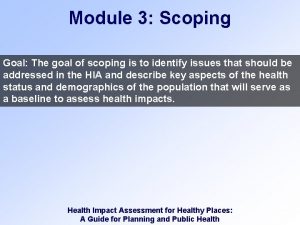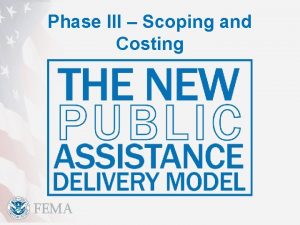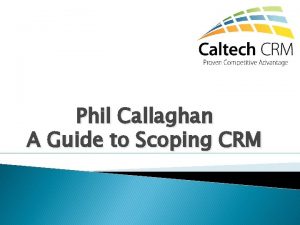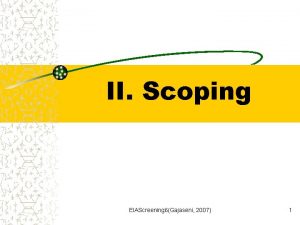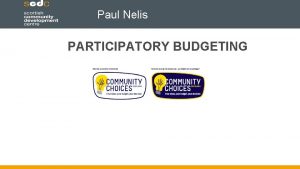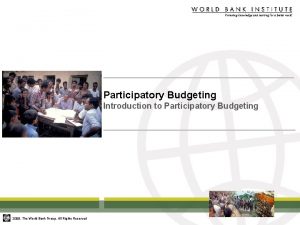Participatory Action Research with Older Adults A Scoping


























- Slides: 26

Participatory Action Research with Older Adults: A Scoping Review AISWR Conference, 14 th June 2019 Jennifer Allen Senior Social Worker NQSW, MSoc. Sc (Social Work), MSc (Bereavement Studies), Ph. D Candidate UCD

Purpose: ØTo discover to what extent PAR has been utilised with older adults within the existing literature base ØParticular focus on healthcare & dementia related PAR research ØTo analyse PARs potential as an empowering research approach ØTo discern how participation was enacted

Carew House, CH East – Older Adult Mental Health Service

Overview: 1. Participatory Action research? – particularly in context of healthcare 2. Research Strategy 3. Findings of scoping review 4. Implications for S. W. Practice

1. Participatory Action Research?

Definition & Origins: Ø Emerged in 1970’s “a participatory process concerned with developing practical knowledge in the pursuit of worthwhile human purposes. It seeks to bring together action and reflection, theory and practice, in participation with others, in the pursuit of practical solutions to issues of pressing concern to people, and more generally the flourishing of individual persons and their communities”. (Reason & Bradbury, 2008, p. 4) Ø Breaks from positivist and empiricist science & critique of mainstream social sciences (Swantz, 2008: 31) Ø Kurt Lewin (1948) – democratic learning & acting Ø Freire (1974) – consciousraising Ø Critical theory & constructivism (Baum, Mac. Dougall & Smith, 2004)

Key Features: Participatory - Life in Society Research - Mind, Knowledge Creating knowledge – Collaboration from – Action for change experience – Participation – Collective reflection PAR Action - Experience Figure: Participatory Action Research, Chevalier and Buckles (2013, p. 10) – Emphasis on process – Co-learning & co-ownership of what is learned

PAR Process: Crane & Richardson (2000)

6 basic PAR principles in gerontological research and practice: (Blair & Minkler, 2009) 1. Participatory – a collaborative & equitable partnership 2. Empowering process 3. Co-learning process 4. Contributes to capacity building and systems change 5. Balances research and action 6. Commitment to long-term collaboration

PAR in Healthcare: • Public and Patient Involvement (PPI) – designing & evaluating services • recognition that clinically acquired knowledge only forms part of the person’s treatment and recovery • Holistic way of viewing health (Hughes, 2008) • Patient’s voice, narrative & wisdom privileged. • Involvement of people to take action to improve their own health and reduce health inequalities (Baum, Mac. Dougall & Smith, 2004)

A. R. used quite widely in healthcare settings to focus on (Meyer, 2000): ØInvolvement of the care-recipient ØIn fostering better practice amongst different disciplines ØBy clinicians in researching their own practice ØTo facilitate closer partnerships between staff and services users

Convergence between PAR & Social Work:

Many core assumptions of PAR are consistent with social work approaches: üCommitment to social justice (Healy, 2001) üAnti-discriminatory and “anti-ageist” practice is central (Thompson, 1998) üPAR draws on conflict theory (Tandon, 1981) üRadical egalitarianism between researchers & participants (Healy, 2001) üInvolves collective action & conscious raising üEmpowerment & liberation of people to enhance-well being (IFSW, 2000)

2. Research Strategy: ØScoping Review ØCINAHL, ASSIA & SSA ØAction Research Journal & International Journal of Action Research ØWith a combination of terms: “Participatory Action Research” And “older adult*” OR “elderly”

Initial Search: 390 Post Title review & Abstract review: Older adult Healthcare: 33 15

Exclusion & Inclusion Criteria: Exclusion criteria: Inclusion criteria: - Full text unavailable - Peer-reviewed & in available in English language - Studies that focused solely on professionals or caregivers experiences - Not older adults - Some were precursors to PAR studies - PAR evaluation studies - Studies where older people were included as co-researchers - Specific focus on healthcare research

Author: 1 2 3 4 5 6 7 8 9 10 11 12 13 14 15 Adili, F. , Higgins, I. , & Koch, T. (2013) Title: Older women and chronic illness: Transitioning and learning to live with diabetes Anderson, J. & Bilfeldt, A. (2015) Action research in nursing homes Beaulieu, R. , Kang, H. & Hino, S. (2017) An action research approach to introduce Dalcroze Eurhythmics Method in a community of older adults as a promising strategy for fall prevention, injury recovery and socialization. Black, K. , Dobbs, D. , & Young, T. L. (2015) Ageing in Community: Mobilizing A New Paradigm of Older Adults as a Core Social Reource Caine, J. (2014) Integrating people with dementia and their carers into service design Chenoweth, L. & Kilstoff, K. (1998) Facilitating positive changes in community dementia management through participatory action research Ellins, J. & Glasby, J. (2016) “You don’t know what you are saying ‘Yes’ and what you are saying ‘No’ to”: hospital experiences of older people from minority ethic communities. Fenge, L. A. (2002) Practising partnership – participative inquiry with older people Hanson, E. , Magnusson, L. , Nolan, J. and Developing a model of participatory research Nolan, M. (2006) involving researchers, practitioners, older people and their family carers: An international collaboration James, I. , Blomberg, K. , Liljekvist, E. & Working together for a meaningful daily life for Kihlgren, A. (2015) older persons: A participatory and appreciative action and reflection project – The lessons we learned Jansen, E. , Baur, V. , de Wit, M. , Wilbrink, Co-designing collaboration: Using a partnership N. & Abma, T. (2015) framework for sharing policymaking in geriatric networks Nomura, M. , Makimoto, K. , Motoko, K. , Empowering older people with early dementia Shiba, T. , Matsumoto, N. , Ikeda, M. (2009) and family caregivers: A participatory action research study Ritchie, J, Bernard, D. , Trede, F. , Hill, B. , & Using a participatory action research approach as Squires, B. (2003) a process for promoting the health of older people Van Malderen, L. , De Vriendt, P. , Mets, T. Active ageing in the nursing home: Could & Gorus, E. (2016) participatory action research provide the answer? Woelders, S. & Abma, T. (2019) Participatory action research to enhance the collective involvement of residents in elderly care: About power, dialogue and understanding Journal: Country: Approach to participation: Action Research Australia Action Research International Journal of Action Research Denmark California Storytelling in one-to-one interviews Storyline Future Workshop Focus group interviews Journal of Applied Gerontology Florida Appreciative Inquiry Integrating people with dementia International Journal of Nursing Practice U. K. Person-centred approach to service user participation Critical reflection – multiple methods clarified themes Ageing & Society U. K. In-depth narrative interviews – spine structure: current & anticipated ‘hopes & fears for the future’ Social Work Education U. K. Journal of Research in Nursing Sweden PAR with “gay and lesbian elders and older people from ethnic minorities” “Carers as experts model” Action Research Sweden Collaboration reflecting group Action Research The Netherlands Int. Journal of Nursing Studies Rural town in Japan “A partnership framework consisting of conditions, actions, relations and values” 3 cycles: individual, group & community Health Promotion Journal of Australia Concurrent process of investigation & action Action Research Belgium Active Ageing (WHO). Participation – individual & organisation level Action Research The Netherlands PARTNER PAR approach – inspired by responsive evaluation. Creating communicative spaces through dialogue Australia

3. Findings:

Themes: § Participation & Empowerment – voices that are seldom heard (eg. nursing home residents) or invisible (eg. minority groups) § Power - Older people often excluded from decision-making § Paradox: power of researchers to initiate & promote participation - redress the power imbalance § Critical Reflection § Blending of knowledge – personalised & professional § Communication – essential for good interpersonal relationships § Emphasis on process – in creating supportive environments & meaningful involvement § Flexibility / fluidity - in response to changing situations

How Participation was enacted: More innovative More traditional qual. approaches: methods: Ø PARTNER approach § Focus groups Ø Individual, Group & Community cycles § Observations Ø Collaborative reflecting group Ø Future Workshop Ø Appreciative inquiry Ø Storyline § In-depth narrative interviews **Multiple collection methods allow for clarification of themes

Challenges of PAR in practice: – Recruitment of eligible participants – Buy in from service providers / managers: – older persons not viewed as competent partners – Gap between “life-world” and the “system” was not easily bridged (Woelders & Abma, 2019) – Time to facilitate engagement (Cain, 2014) – Ultimately produced more substantial insights – Problems occurred – worked together to resolve & create new ways of working

PAR with persons with dementia: – Empowerment: de-stigmatisation of dementia in the community (Nomura et al, 2009) – Creative Methods – visual methods as effective tool for engagement (Caine, 2014) – Key worker approach – MDT working (Caine, 2014) – Portfolio / client observation book (Chenoweth & Kilstoff, 1998; Caine, 2014) – Benefits of PAR accrued to all participants – carers, staff & Pw. D (Chenoweth & Kilstoff, 1998)

4. Implications for S. W. Research:

– PAR is consistent with SW ethics & values – NB of recognising individual identity in older adults – Centrality of issues of power & control and an awareness of them (Fenge, 2002) – NB of continuous loop of feeding back – Ethics & consent – “Model of ongoing consent” (Ellins & Glasby, 2016) – Appreciation that the PAR process can not be determined in advance – Planning & working with stakeholders to produce cycles of reflection & action drive & develop projects (James et al, 2015)

A final thought. . . “Participatory action research (PAR) with older adults may hold promise for helping to understand address some of the complex health and social problems faced by elders while contributing to individual and community capacity building” (Blair & Minkler, 2009, p. 651).

Thank you
 Life is older than the trees
Life is older than the trees Mental health and older adults
Mental health and older adults Mental health and older adults
Mental health and older adults Altered cognition in older adults is commonly attributed to
Altered cognition in older adults is commonly attributed to Conclusion of physical examination
Conclusion of physical examination Renal
Renal Covids older adults
Covids older adults Older adults mental health
Older adults mental health Dynamic stretching for older adults
Dynamic stretching for older adults Pengertian participatory action research
Pengertian participatory action research How do you undertake community scoping
How do you undertake community scoping What is problem scoping?
What is problem scoping? Project scoping exercise
Project scoping exercise Project scoping
Project scoping Dynamic scoping
Dynamic scoping Principles of participatory learning and action
Principles of participatory learning and action 5 advantages of participatory planning approach
5 advantages of participatory planning approach Quantitative research objectives examples
Quantitative research objectives examples Pra in social work
Pra in social work Wealth ranking in pra
Wealth ranking in pra What is participatory development
What is participatory development Participatory budgeting
Participatory budgeting Participatory development
Participatory development Content based task based and participatory approaches
Content based task based and participatory approaches Participatory evaluation
Participatory evaluation Types of representative democracy ap gov
Types of representative democracy ap gov Participatory governance
Participatory governance


